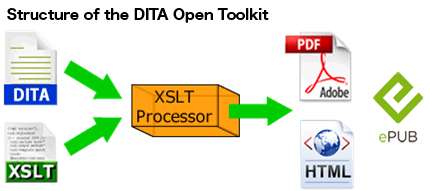We prepare data to match the final medium or format.
Crestec can support many formats and applications, such as InDesign, FrameMaker, and Microsoft Office. We can effectively use your accumulated data assets for efficient manual creation.
1 Supported Applications
Adobe InDesign, Adobe FrameMaker, Adobe PageMaker, Adobe Illustrator, Adobe Photoshop, Microsoft Office, QuarkXPress, Adobe Dreamweaver, Adobe Flash, AH Formatter, Trados, and others
2 Supported File Formats
.indd, .fm, .ai, .psd, .eps, PDF, .pptx, .xlsx, .docx, .pmd, XML (DITA supported), HTML, .swf, WebHelp, CHM, EPUB, KF8, MOBI, .svg, 3D CAD, and XVL and other image files
We can use XML to standardize and structure documents, and create content for various types of media, such as HTML, video, and smartphone apps, based on DTP data. Of course, we are also able to use CMS and DITA to ensure that your data assets can be managed smoothly.
Crestec can use the 3D CAD data for a product to create precise illustrations and also video in the pursuit of content that can communicate clearly.
Because Crestec can create highly accurate translations using our network with operations around the world and has DTP centers in China, Thailand, and other countries, we are able to carry out the work for multiple languages to meet simultaneous worldwide sales.
What is DITA?
Differences between DITA and existing "XML"
What type of manuals
is it suited for?
How should it
be introduced?
DITA proposed
by Crestec
DITA is one of the new document production technologies based on XML. It offers an approach for making easy-to-understand documents. Even more than with other XML technologies, in order to introduce DITA, it is important to understand the specifications and ideology of DITA. Because DITA is combined with existing technologies, if there is a failure to properly combine the data, there is a possibility that it may result in only the data format being changed with no real changes from the previous data.
Why use "DITA"?
Why use "DITA" now rather than any of the many other XML technologies available? It is increasingly necessary to support media other than paper due to the rise of new devices such as smartphones and tablets. Existing content tends to have been made with the assumption that the medium would be paper, and that the content would be in book form and read in order from the beginning. However, to support new devices, it has become necessary to have a topic orientation with compact units that can communicate information.
In addition, in the race for globalization, the desire to reduce translation and DTP costs is greater than ever. It is in this background that DITA, possessing the latest document development specifications and open standards, has gained attention. However, simply introducing DITA doesn't automatically lead to improvements. Let's correctly understand the ideology and concept of DITA to get the most out of this technology.
Topics and Maps
With DITA, topics are used as the basic units to write information, and then by referencing these topics from maps, a single document can be created.
Topics
Topics refers to collections of information that have a fixed meaning from the point of view of users. In DITA, topics do not have a dependent relationship with other topics. There are multiple defined topics referred to as topic types that may be selected and appropriately used according to the content. The main topic types include task, concept, and reference.
Specialization
DITA stands for "Darwin Information Typing Architecture". It uses the "Darwin" name because it is a specialized system that can make new independent topic types. Specialization allows you to make specialized topics from the existing topic types that are more targeted to specific information.
Reuse
In document production, various methods have come to be used for the purpose of making information into components for reuse. DITA comes with a structure that makes reuse easy because documents are made up of component units. The original thinking behind topics was to make them with no dependent relationships with other topics so that they could more easily reused. There are also conref and keyref, which are units of information that are even smaller than topics and that can be utilized to reuse information more precisely. These can be considered as being part of the important specializations that make it possible to greatly affect the efficiency of document production.
Automatic DTP
The DITA Open Toolkit, which makes it possible to convert DITA to various data formats, has been developed as a sourceforge open project which is available for free. However, in order to meet the design levels required for products, plugins for creating data with independent specifications must be developed.

XML Structure Definitions
Have you heard of the phrase "manual structurization"? DocBook was the first manual structurization technology followed by various others. All of these are types of "XML Structure Definitions". Structure definitions are used to determine the shape of the XML in terms of "what elements can appear where" and "what attributes there are for elements". These definitions are determined depending on how the XML will be used. For a familiar example, think of the web pages we view using PCs and other devices. A technology called XHTML is used in some web pages. It can be considered that the form of the XML used in XHTML was determined in order to display web pages. In this way, we can also think of DITA as one type of "XML Structure Definition". DITA has specializations not found in other types of structured technologies. This is the structure definition made for the purpose of "topic oriented writing".
Topic Oriented Writing
Topic oriented writing is bringing together multiple topics to make a single document. In DITA the first thing to do is think of which topic type (task, concept, or reference) to use for the given information. To communicate the information that users want to know in an easy-to-understand manner, the contents of each topic type are classified and structured, and there are fixed guidelines for what should be written where. The DITA topic types form the basis of the InfoMap method. The InfoMap method is based on scientific knowledge from cognitive psychology, and was created as a method to communicate information in an easy-to-understand manner. There is also the term "task oriented". This refers to a way of thinking where "what the reader wants to do" and "what the reader wants to know" are used as topics. This is a commonly used writing method in topic oriented writing in DITA. It is important to understand that the focus of the specifications of DITA on content is for the purpose of making documents with the DITA topic orientated specializations that are easy to read and understand. This is a structure definition that places importance on the role of people rather than the system.
Topic orientated writing can be considered as a way of writing to match the text to a prescribed form. Because there is a prescribed form, even if multiple writers write topics, it is easier to maintain uniformity and consistency in the quality and content. What types of documents would need multiple writers? First of all, we can all think of documents with large amounts of information that are difficult for 1 writer to write. Also, for manuals that are read on smartphones that have the type of contents that could get the most out of the special traits of topic writing, it might be good to consider DITA regardless of the volume of information. However, this does not mean that just any type of document can made simply by using DITA. DITA has its own pros and cons.
Pros
Because DITA is a document structuring technology, it is capable of automatic composition. You can expect DTP cost savings if you are moving from DTP to DITA. This savings can allow you to increase the number of languages and volume of information. Also, thanks to the ability to increase the reuse of content using conref and other features, you can expect savings in translation costs as well. However, if you reuse too much data, it may become difficult to manage the quality of translations and reused content.
Cons
Because DITA is a document structuring technology, the information gets stylized during writing, resulting in expressions that are uniform and have little variety. This makes DITA unsuitable for documents such as manuals with strong visual themes and lavish brochures that are used for sales promotions. It is important to recognize that structure definitions and modes of expression place restrictions on each other.
From new manuals or documents
When making the move from DTP, you can expect some merit from automatic composition. However, you need to thoroughly investigate whether there are benefits to introducing DITA if you want to change a document that has already been structured using a method such as DocBook to DITA. There is also the risk that if DITA is introduced without having a broad understanding of topic oriented writing, you may perform conversion work without getting any real benefit. (There is a demand for data conversion for the purpose of standardizing data.) We are in an age where we must consider that documents will be viewed in a variety of ways on multiple devices, including smartphones, tablet PCs, and the latest browsers. When you are reviewing how to meet the needs of these modes of distribution and browsing formats, it may be a good time to consider introducing DITA.
It's not the purpose - it's the method
If you think of DITA as an aspect of IT solutions, there are almost no limits to the cost of the system you can construct. The point should not be to simply introduce a system or DITA. Importance must be placed on recognizing the methods for making better documents and considering the manner in which DITA is to be introduced.
The importance of designing maps
Maps play an important part in topic oriented writing. Maps clarify the overall image of a document and assign it a role. They also make it clear what types of topics are needed in a document, determine the position for each topic, and assign a role to each topic. This allows writers to know how to use each topic. The ability of maps to clarify design is especially important for documents with multiple writers.
For Crestec, DITA is one out of many technologies for making documents. From the standpoint of the importance of content, Crestec believes that "topic orientated writing" is the essence of DITA. We consider the technologies, experience, and DITA that we have cultivated so far to be seamless, and we continue to study the essence of making documents.
Support for Multiple Devices

Since each device has its own characteristics, the best way of showing content is different for each device. The limitations in expression for each type of device can be understood by considering their various characteristics. For example, on the small screens of smartphones, there are limits to the amount of information that can be displayed. In order to have content that is easy for users to read and understand, we must optimize content according to the limitations of each device. At Crestec, we have writers who understand the characteristics of each device and are here to help you with document production for multiple devices.